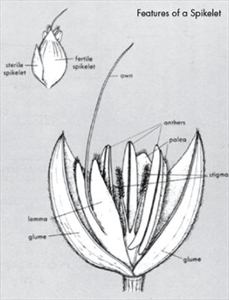Sorghum midge
Pacific Pests, Pathogens, Weeds & Pesticides - Online edition
Pacific Pests, Pathogens, Weeds & Pesticides
Sorghum midge (336)
Stenodiplosis sorghicola; previously, Contarinia sorghicola.
Africa, Asia, North, South and Central America, the Caribbean, Europe, Oceania. It is recorded from Australia, Fiji1, New Caledonia, and Papua New Guinea.
Sorghum (grain and forage), and wild grasses, e.g., columbus grass (a natural cross between sorghum and Johnson grass), Johnson grass, Sudan grass.
A major pest; the larvae eat the young seeds in the heads. Moderate infestations leave a few round, full grains amongst undeveloped shrivelled grains. However, when infestations are severe, full grains are absent.
The midge is mosquito-like, orange, 1.5-2 mm long, with clear wings, long antennae, and, for females, a long thin ovipositor (Diagram). The female lays about 100 eggs, usually singly into the flower spikelets, between the lower 'glume' and 'lemma' (see Diagram). Egg-laying occurs just when the spikelets open so that the larvae have the soft developing seed to feed on. About 90% of the eggs are laid within 4 days of head emergence. The female lives for one day; males for a few hours.
Eggs hatch in 2-3 days, and the larvae are white at first, later becoming orange, 2.5 mm long, and spindle shaped. After about 10 days they pupate. The pupae move to the tip of the glumes about 3 days before adult emergence. The life cycle is about 14 days.
Populations of midge build up in successive crops, with late-flowering crops suffering heavy damage.
Not all the larvae pupate, about 2-3% go into a resting stage (called 'diapause') inside a cocoon, and remain there for up to 5 years. The end of diapause depends on temperature and rainfall.
Spread of the midge occurs when grain is moved containing larvae while in the resting stage.
High midge number can destroy susceptible crops. Worldwide, the midge is estimated to destroy about 10-15% of the sorghum grown. Although early planting is considered a good option to manage the midge, often there are difficulties. In any one area, farmers might plant at different times, with different varieties of varying maturity, giving the midge the chance to migrate from one crop to another, with increasing numbers.
It is best to detect the presence of the midge, rather than waiting for shrivelled seeds to show or for the presence of pupal cases on the spikelets after the adults have emerged. During the bloom stage when the head appears, look for midges:
- Kneel alongside a chosen plant.
- Observe the head against the sky looking for adult midges.
- Count the number of midges seen. [Do not do this on a windy day].
- If no midges seen, lightly tap the stalk below the head to make the adults move.
- Repeat across the field.
- Do this mid-morning at least once every 2 days during the blooming period.
A second method is to use a clear plastic bag placed over the blooming head, tap, remove the bag and count the number of midges. Repeat.
NATURAL ENEMIES
There are several parasitoid wasps: Eupelmus, Tetrastichus and Aprostocetus species. However, the impact of these natural enemies comes late, towards the end of the season, and by then the midge has caused considerable damage. There are general predators, too, but their effect in controlling populations of the midge has not been evaluated.
CULTURAL CONTROL
- Plant early to avoid the heavy infestations that occur with late-planted crops.
- Remove wild grasses from within and around the field, especially Johnson grass. The midge undergoes one or two generations on wild grasses before moving to crops of sorghum.
- Use a high seeding rate to reduce insect damage per plant or per unit area.
- Do not plant sorghum continuously on the same land; rotate with crops of sugar cane or peanuts. Intercropping with legumes may also be beneficial.
- Burn stubble after harvest to reduce the chance of larvae from carrying over between crops, and then plough the fields.
RESISTANT VARIETIES
- Use resistant hybrid varieties - this is the main method of managing the midge.
- Select varieties that head at about the same time.
- Select varieties that do not tiller, i.e., do not produce side shoots from the base of the plants.
CHEMICAL
For many farmers, chemical control will be uneconomic. It is not only expensive, but there is only a short period, at flowering, when it can be done effectively. There is also the problem that the larvae which cause the damage are protected by the glumes. However, if field inspection shows there are more than 1 to 2 midges per head, and pesticides are available, apply a synthetic pyrethroid, e.g., lambda-cyhalothrin or cypermethrin. More than one application will probably be needed.
____________________
When using a pesticide, always wear protective clothing and follow the instructions on the product label, such as dosage, timing of application, and pre-harvest interval. Recommendations will vary with the crop and system of cultivation. Expert advice on the most appropriate pesticide to use should always be sought from local agricultural authorities.
AUTHOR Grahame Jackson
1Information from Swaine G (1971) Agricultural Zoology in Fiji. Her Majesty's Stationery Office. London; and CABI (2015) Stenodiplosis sorghicola (sorghum midge) Crop Protection Compendium (https://www.cabi.org/cpc/datasheet/15237); and from Business Queensland (2020) Sorghum midge. Queensland Government. (https://www.business.qld.gov.au/industries/farms-fishing-forestry/agriculture/crop-growing/pests-field-crops/sorghum-midge); and from DAF (2018) Insect pests management in sorghum. Queensland Government. (https://www.daf.qld.gov.au/business-priorities/agriculture/plants/crops-pastures/broadacre-field-crops/insect-pest-management-specific-crops/insect-pest-management-sorghum#Sorghum_midge). Diagram Mississippi State University Extension. (http://extension.msstate.edu/publications/information-sheets/sorghum-midge-control). Photo 1 Alton N. Sparks, Jr., University of Georgia. Bugwood.org.
Produced with support from the Australian Centre for International Agricultural Research under project PC/2010/090: Strengthening integrated crop management research in the Pacific Islands in support of sustainable intensification of high-value crop production, implemented by the University of Queensland and the Secretariat of the Pacific Community.





